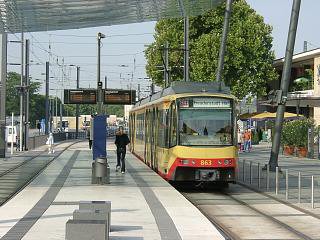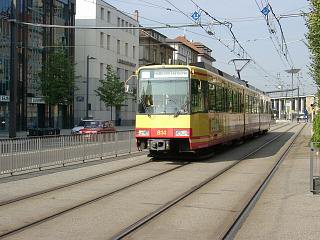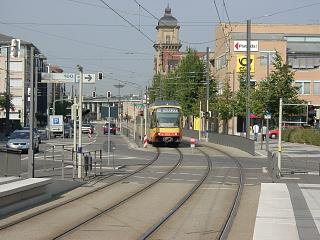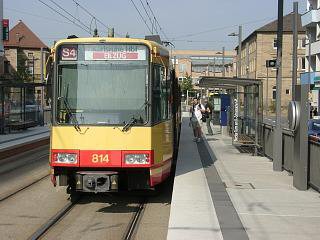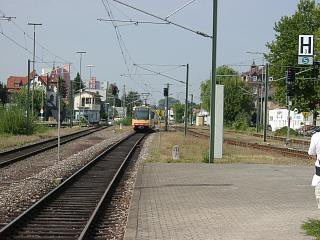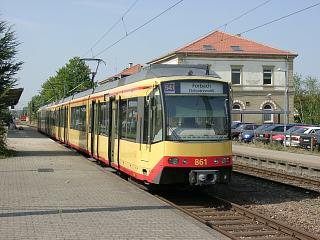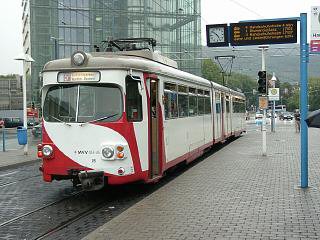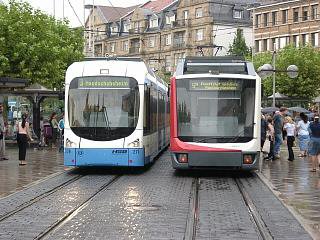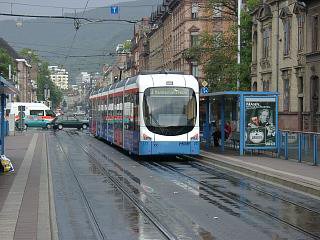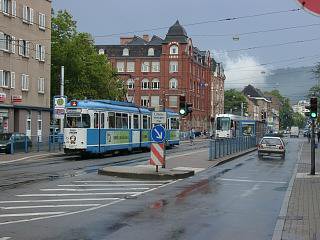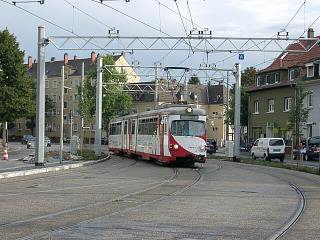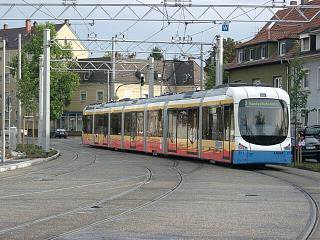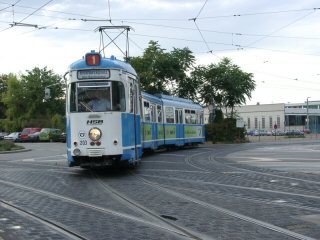"Tram-hiking" through Germany
We left Stuttgart in the early morning by train. Although our destination was Heidelberg, Andrßs has planed our route via Heilbronn, to try the Karlsruhe bi-modal tram-train on a short section.
This bi-modal wondertram can act as a tram/Stadtbahn using 750 V DC, or a "big railway" EMU using 15 kV AC. Karlsruhe was a pioneer in building out a network with such vehicles using the tracks of the Deutsche Bahn AG, and one branch of that network reaches out to Heilbronn.
DUEWAG GT8-100D/M2SY articulated car - the second generation of bi-modal vehicles in Karlsruhe - in front of the Heilbronn railway station. This section lies in the city streets, but it's energized with 15 kilovolts DC.
The current-switching point is only a few meters away: this GT8-100C/2SY - a first generation vehicle - comes from the stop we have seen on the previous picture, and has already reached the insulated section, where there's no current in the overhead wire. The next section, which starts at the blue signs above the car, is energized with 750 V DC. The electronics of the car (supplied by ABB, later ADtranz) recognizes the current type and switches into the appropriate mode.
Another new(er) articulated car seen from the platform of the next stop...
... and there's that older one again! By the way, there are plans the extend the system deeper into the Heilbronn area.
The railway station of Eppingen, where we alighted after half an hour of travelling.
A double-set of bi-modal vehicles. Note the folding stairs acting as a bridge over the gap between the car and the platform designed for normal railway cars.
After a longer stop at the Sinsheim Auto&Technik Museum, we finally arrived to Heidelberg, a beautiful city in the Rhine-Neckar area.
HSB, the city's own transportation company operates four meter-gauge tramlines, but cars of OEG, the Oberrheinische Eisenbahn-Gesellschaft can also be seen on the tracks. The D▄WAG 8-axle articulated car on the picture was photographed at the main railway station.
Bismarckplatz, in the heart of the city, where tram lines meet. As we arrived, ther was a tie-up in traffic, so we could take photos of all car types used here. Unfortunately we were then struck by "Hamster weather" in form of a heavy drencher. Anyway, the vehicle to the right is a 1975 D▄WAG 8-axle articulated car, which looks just like the original GT8 first produced in 1957. Of course I can understand HSB purchasing these old-looking cars instead of the boxy cars of the seventies!
Another strange fellow: a DUEWAG MGT6D (partly) low-floor car with the front-design of the older M8-series (an M8C can be made out to the left).
Two (ABB-Henschel-Stadler-LHB-ADtranz-Bombardier - these are the companies I found to be affiliated with this design, I wonder who the real father is!) "Variobahn" vehicles: an older one used by OEG to the right, and a newer to the left, as used by HSB.
Another MGT6D.
The rainclouds have made everything too dark for photographing, so we hiked around with trams (M8 and MGT6D) for a while. We then alighted at Betriebshof (Depot).
Things started to get better as the rainshower became weaker and weaker. On the picture above: a Variobahn.
Three old 6-axle D▄WAG cars at the carbarn.
A GT8 and an M8C.
We then tried a Variobahn and travelled with it until the stop OEG-Bahnhof, where I took this photo of an OEG 8-axle car.
Here's another double-sided, bidirectional Variobahn of the HSB.
The interior of a Variobahn.
We returned to Bismarckplatz hoping to be able to take nicer pictures then an hour ago, but the sun was already setting, so it was too dark again. Damn!
I perpetuated this GT8 in the bend near the railway station, then we boarded an OEG 8-axle car heading for Mannheim, our next stop.
Next page: Mannheim and Ludwigshafen
Back to the top
Back to the beginning
Back to the main page
HamPage
